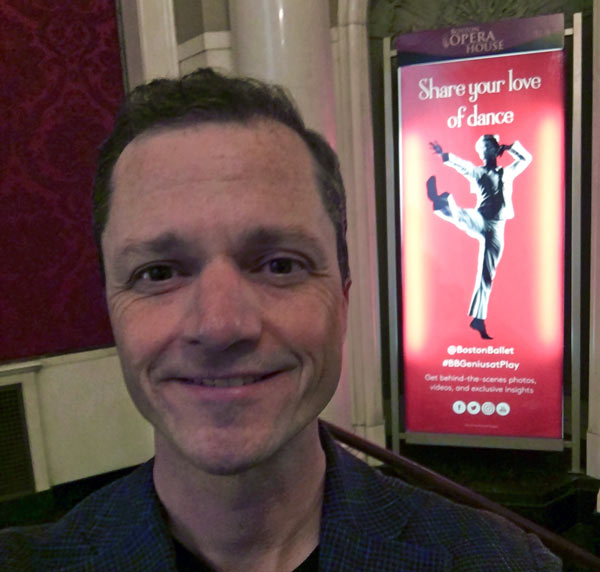Arts and Culture
Article
The Culturephiles
35fe2010-0e6f-43c3-92d4-b1f25017ca7f
3 min
https://edge.sitecorecloud.io/tessituraneab9a-tessiturane5642-staging-5396/media/Images/Discover-Images/Andrew-Blog/Archive/ballet-toe-shoes-768x465.jpg?h=465&iar=0&w=768
Everything in life can be improved with a checklist.
A Novice Learns to Love Ballet

President & CEO, Tessitura
A Novice Learns to Love Ballet
1/28/2019
3 min
Everything in life can be improved with a checklist.
It was 4:15 on a Saturday morning when I made my first-ever impulse purchase of a ticket to the ballet.
I was alone in Boston after a week in London. Still on London time, I bought a ticket online to whatever the heck the Boston Ballet had on for that night. Why the sudden urge to see ballet? Because I was on a roll.
The prior weekend, in London, I had overcome a long-standing insecurity by cracking how to deeply enjoy an art museum. As detailed in this post, my breakthrough was a simple checklist to change how I viewed art.
Now I was going to press my luck with another art form that had long eluded me: Ballet.
Like art museums, I’ve always wanted to love ballet. I was just so intimidated by it. Maybe it was all the French. I dunno. Anyway, the die was cast.
Now what? Could there be simple techniques for novices like me to truly connect with ballet? I believed yes. Why? Because of Recinos Axiom #1: Everything in life can be improved by a checklist.

Impulse Ballet
As the day unfolded, I refined my Connecting with Ballet checklist down to four essential items:
1. Find Common Ground.
I suspect there are others like me who presume that the ballet will be so highfalutin that they will sit in the audience all night worrying that someone will quiz them afterwards. (“And what was your opinion of the Plume Fleur de Boeuf in the Second Act?”). Perhaps some of ballet is highfalutin, but I was sure that I could find something to relate to.
And here’s a secret. Ballet companies know we worry about these sorts of things. So they have gone to clever lengths to give us newbies easy points of entry. The Boston Ballet was no exception. This production was called “Genius at Play,” a celebration of the 100th birthdays of both Leonard Bernstein and Jerome Robbins.
Bernstein — Be-boppy rhythms and lush melodies! And Jerome Robbins! The choreographer, director and brainchild behind West Side Story. All those Jets and Sharks dancing and snapping their way across the blacktop at oblique angles with hunched shoulders and Brill Cream. That’s ballet? An evening with these two guys didn’t seem like anything to worry about, and there was not a lick of French to be seen. To connect with ballet, look for the places where you already have some common ground.
2. Don’t expect The Nutcracker (and that’s a good thing).
Raise your hand if the only ballet you’ve ever seen is The Nutcracker. I thought so. And let me just say, on behalf of the arts world, thank you for going to see the ballet. It keeps us all in business. Bless you. Please put your hands down.
With that said, only going to see The Nutcracker is a bit like saying you only watch one movie a year and that movie is It’s a Wonderful Life. Turns out those same exact Waltzing Flowers and Warrior Mice have range. Jimmy Stewart had a few other movies, too. In fact, if you are one of those people who go to The Nutcracker every year by family obligation, you may find that you actually prefer the Rear Window Jimmy Stewart to good old George Bailey. (But don’t stop going to see The Nutcracker. We need you.) Revel in dance that isn’t The Nutcracker — what have you been missing?
3. Joy.
Part of my toolkit was to really focus on the pure athleticism of the dancers. If you get to visit the offices of ballet companies like I do, one thing you will learn is that ballet facilities have more in common with Olympic training camps than arts offices. The “instrument” of a dancer is their body.
That night, I focused on this aspect. ABS-olutely impressive. But then something interesting happened. After a while, my brain went past the muscles and flexibility to a word that just kept returning: Joy. It seemed to flow out of their bodies! Whether the moment on stage was happy, sad, or frenetic, it all pulsed with raw, physical joy. Ballet is like singing with your whole body. Let the joy wash over you.
4. See Past the Dance.
Most ballet is more than dance. There’s music. There’s lighting. There’s costumes and perhaps even props and sets. Dance might be the main course, but enjoy the full meal.
This production was all choreographed by Jerome Robbins, but the music was not exclusively Bernstein. The last piece was a late-career work by Robbins called Glass Pieces with a score by Phillip Glass. It was like the 1980s in a bottle. The ruthless precision of the music was the embodiment of the urban rat race of the time: Yuppies. The Macintosh computer. Graph paper. The lighting and costumes matched the music toe-to-toe: cool metallic pastels.
It was after taking in this entire canvas that the dance itself seeped in: straight lines and columns of arms and legs at right angles and sharp movements — personifying the cold industry of the decade. By widening the frame of my senses, I took in the whole world of the work, not “just” the dance. Breathtaking.
* * *
In the immortal words of another one of the twentieth century’s great choreographers:
“I am sure that levitation is possible.”
— Martha Graham
After that night, I am sure, too. Not just physically, but in our hearts as well. Next time you need a little levitation in your life, go to the ballet.
(Just remember your checklist.)
Topics
Arts & Culture
